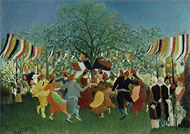Grades/Level: Lower Elementary (K–2), Upper Elementary (3–5)
Subjects: Visual Arts, History–Social Science
Time Required: 2–Part Lesson
2-3 class periods
Author: J. Paul Getty Museum Education Staff
Permissions: 
The lesson plan and downloadable materials on this page are licensed under a Creative Commons Attribution 4.0 International License. |
 |
|
 |
Download the complete lesson by clicking on the "download this lesson" icon above.
Additional Resource:
Learn more about and compare A Centennial of Independence by Henri Rousseau and Christ's Entry into Brussels in 1889 by James Ensor.
Glossary Terms:
Words in bold on these pages and in the lesson are defined in the glossary for this curriculum (see "For the Classroom" links above).
|
 |
 |
 |
| A Centennial of Independence, Henri Rousseau, 1892 |
 |
|
 |
Common Core Standards for English Language Arts
Grades K–5
SPEAKING AND LISTENING
K.1 Participate in collaborative conversations with diverse partners about kindergarten topics and text with peers and adults in small and larger groups.
K.4 Describe familiar people places, things, and events, with prompting and support, provide additional detail.
1.3 Ask and answer questions about what a speaker says in order to gather additional information or clarify something that is not understood.
2.3 Ask and answer questions about what a speaker says in order to clarify comprehension, gather information, or deepen understanding of a topic or issue.
3.1 Engage effectively in a range of collaborative discussions (one-on-one, in groups, and teacher-led) with diverse partners on grade 3 topics and texts, building on others' ideas and expressing their own clearly.
4.1 Engage effectively in a range of collaborative discussions (one-on-one, in groups, and teacher-led) with diverse partners on grade 4 topics and texts, building on others' ideas and expressing their own clearly.
4.3 Identify the reasons and evidence a speaker or media source provides to support particular points.
5.1 Engage effectively in a range of collaborative discussions (one-on-one, in groups, and teacher-led) with diverse partners on grade 5 topics and texts, building on others' ideas and expressing their own clearly.
5.3 Summarize the points a speaker or media source makes and explain how each claim is supported by reasons and evidence, and identify and analyze any logical fallacies.
For more national and California state standards for this curriculum, refer to the charts found in the links at the top right of this page. |
 |

|
 |



